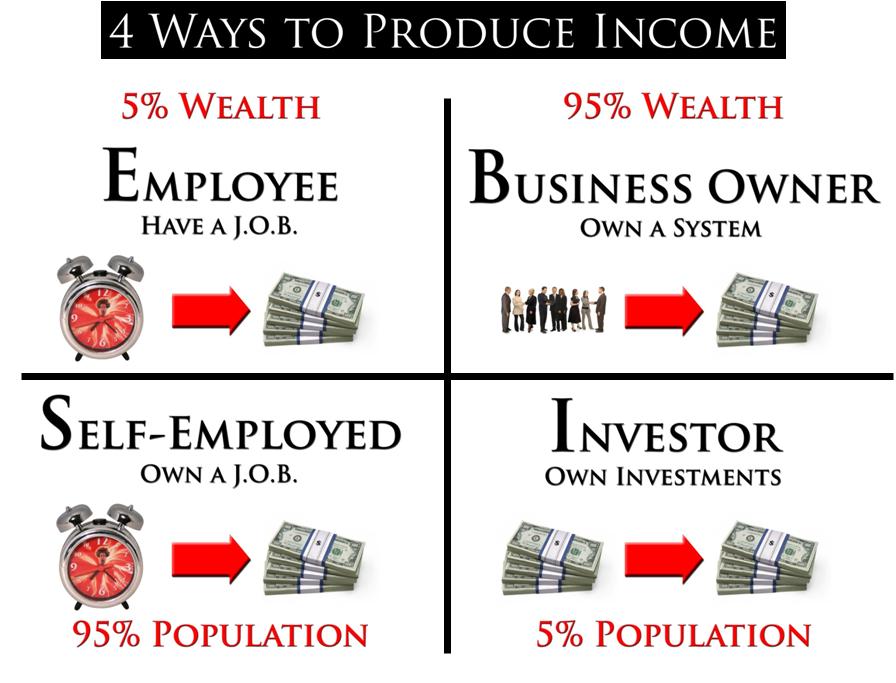Book Review: “Cashflow Quadrant” by Robert Kiyosaki

The "Cashflow Quadrant" by Robert Kiyosaki is a book that explores the different ways individuals can generate income and build wealth. The book is divided into four quadrants, each of which represents a different type of income-generating strategy.
The first quadrant is the "Employee" quadrant, which represents individuals who work for someone else and receive a pay check. These individuals have a limited potential for financial growth and are dependent on their employer for their income.
The second quadrant is the "Self-Employed" quadrant, which represents individuals who own their own business but are still dependent on their own efforts to generate income. These individuals have more potential for financial growth than employees, but they are still dependent on their own efforts and time to generate income.
The third quadrant is the "Business Owner" quadrant, which represents individuals who own and run a business that generates income without their active involvement. These individuals have the most potential for financial growth as they are able to leverage their money and other people's efforts to generate income.
The fourth quadrant is the "Investor" quadrant, which represents individuals who invest their money to generate income. These individuals have the greatest potential for financial growth as they are able to leverage their money to generate income without their active involvement.
Moving from the left side to the right side quadrants in the "Cashflow Quadrant" model typically involves a shift in mindset and strategy.
To move from the "Employee" quadrant to the "Self-Employed" quadrant, an individual can start a side hustle or a small business while still working a full-time job. This can involve developing a skill or expertise and monetizing it, such as starting a consulting business or offering freelance services. As the business grows, the individual can eventually transition to being fully self-employed.
To move from the "Self-Employed" quadrant to the "Business Owner" quadrant, an individual can focus on building a business that can run without their active involvement. This can involve hiring employees, delegating tasks, and systems and processes to run the business efficiently. The key is to focus on creating a business that generates income without the need for the owner to be involved in day-to-day operations.
To move from the "Business Owner" quadrant to the "Investor" quadrant, an individual can focus on investing their money and time in income-generating assets such as stocks, bonds, real estate, or other passive income opportunities. This can involve learning about different investment options and developing a diversified investment portfolio.
It's important to note that, moving from one quadrant to another is a process that takes time, effort and most importantly patience, it's not a switch that happens overnight, but with a good plan, hard work and the right mindset, one can eventually achieve the goal.
"Cashflow Quadrant" by Robert Kiyosaki has received both positive and negative reviews. Some critics argue that the book oversimplifies the process of building wealth and that the quadrant model is too rigid. They argue that the book does not take into account the unique circumstances and challenges that individuals may face when trying to move from one quadrant to another.
Additionally, some reviewers critique the author's idea of becoming rich through real estate investments, without providing a deeper understanding of the real estate market and how to invest in it successfully. They also point out that the author's own success story is not representative of the average person's experience and may not be applicable to most readers.
Another criticism is that the author's writing style can be repetitive, and some of the ideas presented in the book are not original. Some critics also take issue with the author's emphasis on financial independence through aggressive wealth-building strategies, which they argue may not be suitable for everyone and could lead to financial problems if not done carefully.
It's important to note that, while the book has its criticisms, it still has a number of loyal followers and readers who have found value in the author's ideas and strategies. Ultimately, whether the book is useful or not, depends on the reader's perspective, expectations and the stage of the financial journey.
Overall, the "Cashflow Quadrant" provides a valuable framework for understanding the different ways to generate income and build wealth. It is an easy read and it's a good introduction to personal finance, and the author's ideas are clear and well-explained.
